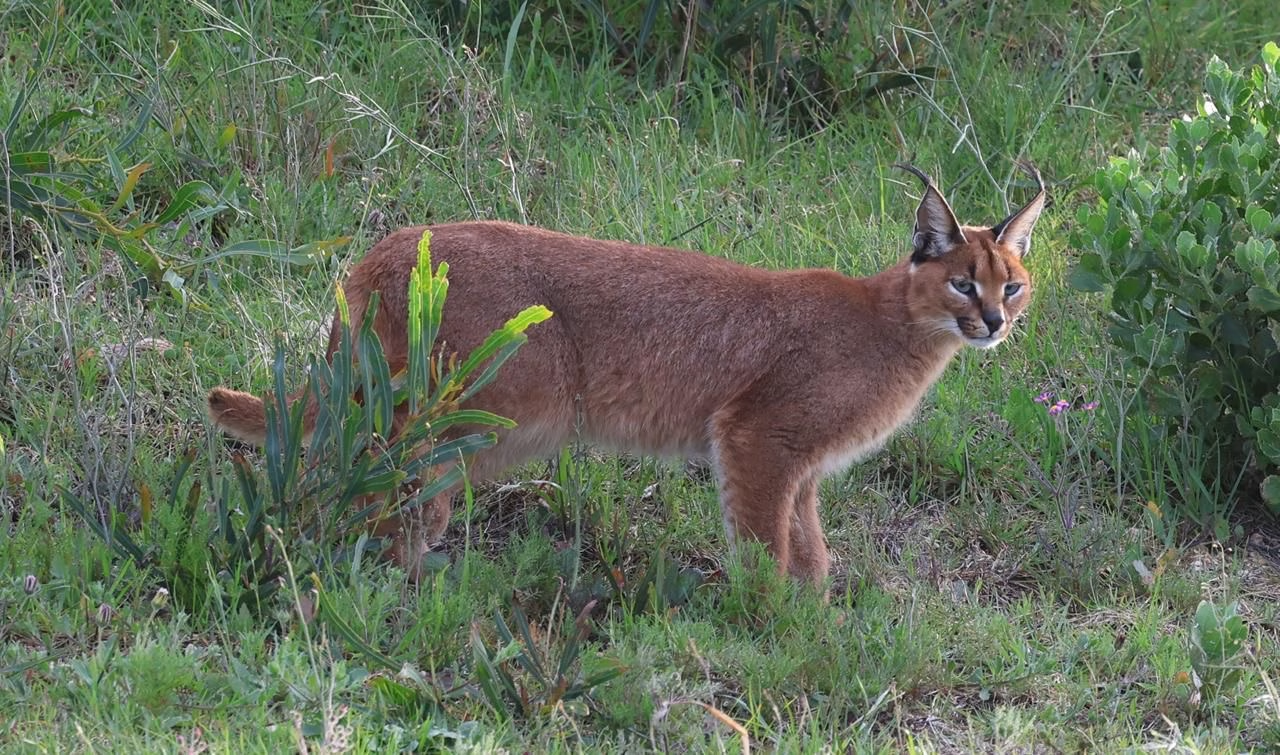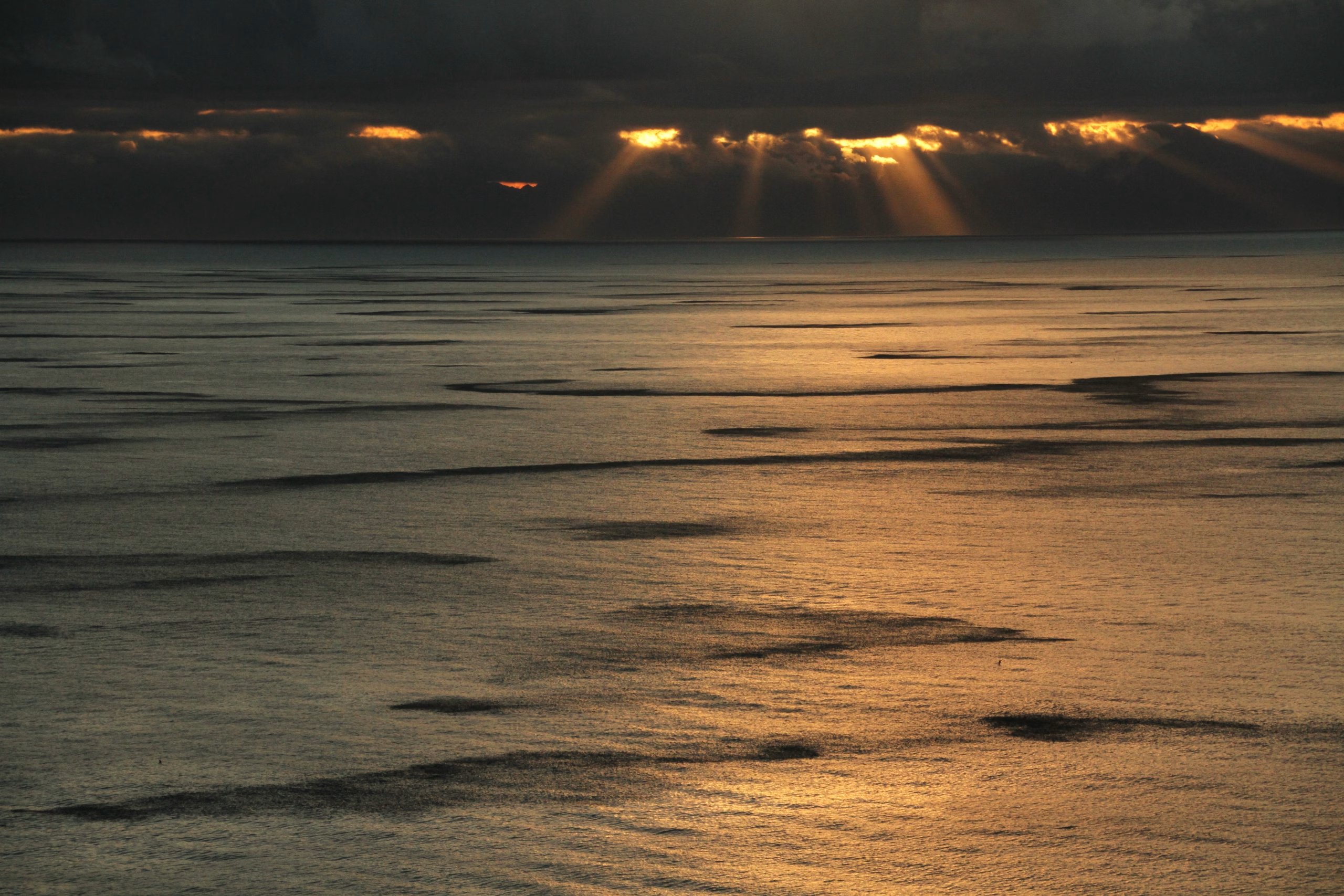When Words Fail Us, We Fail Nature
SWATI THIYAGARAJAN
Soft damp sand squeezed between my toes. Alongside my human footprint were the perfect tracks of a caracal. Meandering along the shoreline, the cat had gone back and forth several times.
Examining the tracks, I wondered about the size of the animal. The tracks told me it was an adult. Was it male or female? Why was it going back and forth so much? Why was it choosing to walk here, close to the water, and not further up on the shoreline? Was it just walking around or was it stalking something? The land was talking to me, and I was trying to understand this language.
Sometimes the tracks had only the soft pad impressions, and sometimes the claws were out. Other tracks looked to have been dug a little deeper, where the caracal had either loped or jumped as it went down a slope. The scatter of sand on rocks also indicated where on the rocks it had crossed before walking on the sand again. There was even a moment where the tracks of the cat meandered with the tracks of an otter, making me wonder which animal had crossed first. Probably the otter, as the tracks further along were more degraded while the cat tracks stayed fresh. As I followed, the tracks also fell into a perfect register – cats sometimes have this way of walking where their hind paws fall directly into the tracks made by the forepaws. It gives them stability, as their forepaws have already tested the ground, as well as stealth and the ability to navigate narrow spaces. In this way, they can stalk silently and confidently. In another spot, the back foot was slightly ahead of the forefoot instead of the perfect register, indicating the animal had picked up speed.
Suddenly, I noticed something interesting. The caracal’s footprints were very clear where the waves’ tracks curved on the sand. As it was nearing low tide, I realised that the cat must have walked here after the tide had already begun to recede. Just a little further along, the tracks disappeared only to appear again and then disappear, and so on. The cat had walked between receding wave lengths as the tide pulled out. It had clearly walked this shore much more recently than I had initially thought. Now, the land had been emphatic, and I began to think beyond just the tracks and started imagining where the cat was headed.
Left: The caracal tracks along the tide mark.
Right: Here we could see that the cat had been moving faster as the hind paws are ahead of the fore paws in the tracks.
Photos by Craig Foster.
The tracks falling into perfect register, and appearing and disappearing with the tide.
Photos by Craig Foster.
Around me were sand dunes, thick vegetation and rocky slopes. I suddenly had the feeling of being watched. I felt it so keenly that I turned and looked in the direction of where I felt the gaze. There was the caracal, staring at me from one of the boulders on the slope. My heart gave one hard kick as I gazed wilderness in its eyes. After a few seconds of observing each other, the cat slunk away, vanishing before my eyes, its perfect orange coat blending into the rocky surroundings.
What had started out as a quiet monologue by the land had bloomed into a conversation. The tracks had been telling me a story and I had been following it; my mind nabbing clues and cues and translating them into my own language. As I concentrated more deeply, revelations appeared until I was face to face with the wild. We had been in dialogue, my whole body a radar of interpretation, to the point that I sensed the gaze of the cat.

Photo by Swati Thiyagarajan.
Often, out in the wild, it is this language I search for, that I want to learn better and be in dialogue with. A language that flowed with ease for our ancestors who walked these wild shores, and still flows through most indigenous communities who live with the land. A huge part of their belonging and connection is due to this fluency in the language of the wild.
Somewhere in our recent history, we have lost that language.
A recent study by Professor Miles Richardson, published in the journal Earth, found there has been a 60% decline in people’s connection to nature since the 1800s. Computer modelling has predicted that this decline will continue unless there are big societal shifts, including introducing children to nature at a young age. The modelling also recommends that urban spaces be made dramatically more green. The study tracked this loss of nature in our lives by analysing data from over 220 years of the changing urban landscape – observing the loss of local flora and fauna, as well as parents themselves becoming disconnected from nature.
Literature over the same time period, according to the study, also showed a great reduction of natural words such as “moss”, “blossom” and “river”. This loss of nature in our language reflects the breakdown in communication between urban humans and the wild. The study concluded that the decline we see today in the natural world is a direct result of this disconnection.
When words are formed and shaped by our tongues, they are a production of our thoughts. When we think of something, we can then express it. If we are not referencing, hearing or speaking words of nature, it means it’s not in our thoughts. And it’s hard for our thoughts to dwell on nature if we live in environments that are depleted of wilderness. Around the world, systematic epistemicide – or the destruction of indigenous knowledge systems – has wiped out languages. Unique ways of seeing the natural world, including generations of lived knowledge, have been lost along with these languages. This diminished awareness of the very fabric of life has allowed us to act in ways that have landed us in the sixth mass extinction event, with climate change and biodiversity loss challenging our very existence.

If language is the connectivity bridge, then words are powerful tools in our endeavours to rebuild that which we have lost. Is there a reason why conversation is an anagram for conservation? Can the right word make a difference?
Let’s look at the word “Earth”. As humans, our lives are mainly land-based, so it’s no surprise that our concerns tend to focus on the terrestrial. However, considering that more than 70% of Earth’s surface is covered by water, it’s curious that the planet’s name doesn’t reflect that. The word “Earth” evolved from old English and Germanic words such as Erde, which translates as “dry soil”, “ground” or “land”. This underlined what mattered most to our species: the ground beneath our feet. This certainly skewed our focus towards land-based priorities for a long time, and even now, in this time of great biodiversity and climate-change upheavals, the ocean is lost in many conversations and meetings, despite being one of the biggest influencers of weather and climate, and harbouring the vast majority of our planet’s biodiversity.
When it comes to names, we have also divided up the Ocean into geographic Oceans, such as the Atlantic, the Pacific, the Indian, and so on, making us think we have several oceans on the planet. In reality, it is all just one Ocean – one vast, borderless body of life-giving water that laps at multiple shores. Why does this matter? Because by viewing our Ocean as one continuous system, we come to be aware that all things good and all things bad occurring in one part affect the whole. We forgot that without the Ocean, life on earth would have been impossible.
The language we use also shapes our ecological perceptions – and reflects how far we have drifted from Mother Nature. The dismissal of grasslands and wetlands as “wastelands” because they don’t have trees has resulted in widespread loss of some of the most biodiverse, water- and carbon-rich environments. By calling coastal areas “Exclusive Economic Zones”, we have stripped the ocean of its wonder of life and diversity and reduced it to a resource. The idea that deserts are merely vast lifeless expanses has changed desert ecology through “green intervention”. By referring to islands as “small island nations”, we have forgotten that they are “large ocean territories”. By defining “urban” as space outside of nature, we have created metropolises and megapolises devoid of life, where pesticide-nurtured lawns are seen as more aesthetic than wild flowers and weeds abundant with butterflies and bees. By calling indigenous lifestyles “primitive”, we justified multiple genocides.
Life and death underwater.
Photos by Helen Walne.
But here we are, the lost human animal. The loss of our wild language is causing a fracture in our spirits. We live in a world where our children can identify five brands faster than they can five plants and animals. Where the words “profit”, “money” and “productivity” have become more commonplace than “happy”, “fulfilled” and “enough”.
The muting of this language has snapped the reciprocity that was our strongest thread with nature. Where we used to receive natural services as a gift, obliging us to behave with grace and return the favour where we could. Where we saw nature as “Source” and not just a resource. In losing the ability to express this language, we have lost the ability to relate to nature, and the sense of where we fit within the natural world.
The greatest loss has been the loss of empathy. In feeling, expressing and relating to the wild world around us, we create within us the feeling of kinship, where we see family in the trees, the rivers, the mountains, the ocean and all of the animals. When everything in nature is family, how could you possibly imagine its destruction? In the act of tracking, we are in dialogue with the wild, and it’s in that knowing that empathy grows, not just for the natural world but for each other too.
Perhaps the most abstract, but keenly felt, result of the disappearance of this language is the loss of wonder. If rain is taken for granted as just water falling from the sky, we lose the beauty and imagination of seeing it as ancient water, 4 billion years old, still replenishing life. The same water that dropped down the long brontosaurus’ neck, helped the first tree grow, is blown out by a blue whale, or captured from the tail of an ice comet, and is now falling on us. It is precious, endless and eternal. If that’s how we saw it, would we waste it? Would we allow sewage, plastics and chemicals to taint it?
This sense of wonder is rooted in the difference between describing nature as “it” and recognising it as a being. The former sees it as an object and the latter as a living, animate spirit. One allows exploitation, while the other forces contemplation of sentience and relationship. Indigenous languages give her form and being through stories affirming her inherent life and importance beyond human-based usage.
It’s in regaining the wonder, understanding that deep nature connection is the path to preservation and regeneration, and in reclaiming the lost language, that we can re-forge our inherent connection to nature and heal the world and ourselves.
"The Earth has music for those who listen."
WIlliam Shakespeare
Intro photo by Diogo Domingues.